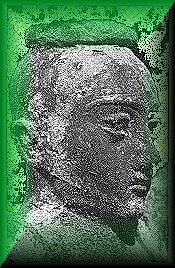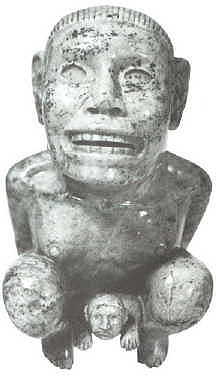(IE entries in parentheses are keywords in Pokorny 1959)
entries marked by ** have been reconstructed by the author
[S = Sumerian; ES = Emesal dialect; B
= Basque;
IE =
Indo-European; E = Egyptian; A =
Arabic;
numbers after Sumerian entries are
sign or combination-sign numbers in Jaritz 1967;
numbers after Basque entries are
entry numbers in the PL-IE-Basque essay at this
website]
x after a Sumerian entry indicates a reading for a
sign by the author which has
not (yet) been acknowledged by Sumerologists; and, as a consequence, has no official number
assigned
|

INDEX OF GRAMMATICAL
FORMANTS AND SELECTED VOCABULARY
† current interpretation by Sumerologists
any formant beginning with a vowel is sometimes seen
as a resumption of the preceding consonant plus vowel
1. Noun + -Ø, subject of intransitive or passive transitive verb; object of active transitive verb; † "absolutive"; (PL Ø)
2.Noun + -Ø, 'at' (locative); † not recognized; (PL Ø)
1.Noun + reduplication, totality, 'all'; † "all"; (PL reduplication)
1.Verb + reduplication, for CV-verbs, progressive/imperfective (marû); for (C)VC-verbs, intensivity = 'all the way' (emphatic hamTu); for (C)VC progressive/imperfective, see -î below; † durativity (marû); (PL reduplication)
1. Noun + -a, 'on' (superessive); † "locative"; (PL ?A, 'here, [plant-]top')
a. Noun + -a, genitive; † "not recognized except as reduction of -ak-"; (PL ?A, 'here')
2. Noun or Adjective + -a, 'this'; † "not assigned a meaning"; (PL ?A, 'here')
3. a- + Verb, marker of immediate time (usually present); imperative: 'immediately'; † "not specified"; (PL ?A, 'here')
4. Verbal Chain + -a-, adverbial 'here'; † "marker of 1st or 2nd person(?)"; (PL ?A, 'here')
5. Verbal Phrase + -a1, 'this' (phrase nominalizer: 'this one who/which . . .'); † "subordinative"; (PL ?A, 'here')
1. a.ba, 'who?'; † "who?"; (PL ?A-P[?]A, 'here-some(one)?')
Noun + -ak(**a/u)-, genitive; † "genitive"; (PL HHA-KX[H]O, 'water-mollusc' = 'sea-shell, valuable possession')
1. al- + Verb, 'perfective, (cause to )persist, always, ever; † "stative"; (PL ?A-N[H]A, 'top-move' = 'mature')
1. ana or ana3, 'one' (cardinal); † "one(?)"; (PL ?A-NA, 'here-one' = 'this one')
1. a.na, 'what?'; † "what?"; (PL ?A-NA, 'here-one?')
1. a.nê, 'one' (pronominal); † "he/she"; (PL ?A-NA-¿E, 'here-one-like' = '(this) one')
1. a.nê.nê, 'all ones' (pronominal) [Old Sumerian]; † "they"; (PL ?A-NA-¿E -NA-¿E, 'here-one-like-one-like' = 'all ones here')
1. -a.nê.nî5, '(belonging to) all ones (pronominal)'; † "their (animate)" (Sumerologists read -a.ne.ne); (PL
?A + NA-¿E-NA-¿E-¿E, 'here-one-like-one-like-like' = '(belonging to) all ones here')
1. Noun + -anî, 'one's' (pronominal); † "his/her"; (PL ?A-NA-¿E-¿E, 'here-one-like-like' = '(this) one-like')
1. Verbal Chain + -b-, durative, partitive (this is probably the Sumerian expression of an antipassive indicating a partial execution of the verbal idea in relationship to the object); † "3rd person subject or object (inanimate)"; (PL P[?]A, 'part')
1. Noun + -ba, 'over, past'; † "-bi + -a"; (PL P[H]A, 'over' = 'past {space}')
2. ba- + Verb, perfect, 'had . . .ed'; † "not defined"; (PL P[H]A, 'over' = 'past {time}')
3. Verbal Phrase + (-a) + -ba, 'after'; † "-bi + -a"; (PL P[H]A, 'over' = 'past {time}')
1. ba-ra (derived from **par2 + -a-, 'here') + Verb, '(I) exclude here that . . .'; † "vetitive with marû; negative affirmative with hamTu"; (PL P[?]FA-RE, ''make to be outstanding=put outside=exclude+here')
1. **bê, 'somone/thing' (pronominal) - not attested; † "not recognized"; (PL P[?]A-¿E, 'part-like')
1. Noun + -bî (written bi, the result of a contraction of **bê + -**î, '-like'), 'someone/thing's'; † -bi, 'its, their (inanimate)'; (PL P[?]A-¿E-¿E, 'piece-like-like')
1. Noun or Adjective + -bî, 'over to'; † "forms adverbs"; (PL P[H]A, 'over, past' + HHE-¿E, 'go-ing')
1. bi2(better pi5) + Verb, 'around'; † "ba + i3"; (PL P[?]FE-¿E, 'foot-like' = "toe/digit" = "around")
1. Noun + -da / -da5 (Old Sumerian), 'with' (lative but also comitative); † "comitative"; (PL T[?]A, '(at) hand')
a. Noun + -bî-da, 'and (=with its)'; † "and"; (PL P[?]A-¿E-¿E, 'piece-like-like=its' + T[?]A, '(at) hand')
b. Noun + -da nu-(better nÛ-)mê-a, 'without (=never being there with)'; † "without"; (PL T[?]A, '(at) hand' + NA-?A-F[H]A, 'inside' + stative + 'go around' = 'not again = never' + MA, '(be) there' + -¿E, '-like' = imperfective = 'being there' + -?A, 'this' = phrase nominalizer, = 'absence')
2. Verbal Chain + -da-, adverbial modification of verbal idea with 'co-'; resumption of previous Noun + -da(?); † "abilitative, resumption of previous Noun + -da-"; (PL T[?]A, '(at) hand')
1. Verb (+ -î) + -da (better -du20), iterative (marû) and habitual hamTu with or without intensive reduplication); † "-ed-a, subordinate marû form"; (PL -T[H]O, 'approach, move together')
1. Verb (+ -î) + -de3 (better -nê), adverbial 'inside, while'; † "supposedly an anomalous form of -da, 'with'"; (PL NA, 'interior' + ¿E, 'interior-like=within')
1. Verbal Chain + -de3 (better -dî7-; also -di-, and -de4- in Old Babylonian literary texts), adverbial 'to the side'; † "supposedly an anomalous form of -da-, 'with'"; (PL T[?]A, '(at) hand' + HHE-¿E, 'go-ing' = 'to the side')
1. Verbal Chain + -dî7- (considered by Sumerologists to be -de3-); also -di-, and -de4- in Old Babylonian literary texts), adverbial 'to the side'; † "supposedly an anomalous form of -da-, 'with'"; (PL T[?]A, '(at) hand' + HHE-¿E, 'go-ing' = 'to the side')
2. Verbal Chain + -de3, nominalizes a marû verbal form for clauses of intention or purpose (better ni5; see below)
1. Verb (+ -î) + -du20 (considered by Sumerologists to be -da; see above under -da), iterative (marû) and habitual hamTu with or without intensive reduplication); † "-ed-a, subordinate marû form"; (PL -T[H]O, 'approach, move together')
1. Noun + -ê, 'nearby' (proximative); subject of active transitive verb; † "ergative"; (PL ?A-¿E, 'here-like')
NOTE: This and the terminative may be datives based on ê, 'go to'.
a. Noun + -ê, 'nearby, in connection with'; † "locative-terminative"; (PL ?A-¿E, 'here-like')
b. Noun + -ê, 'that (nearby)'; † "demonstrative, 'this'; (PL ?A-¿E, 'here-like')
2. ê- + Verb, marker of non-concomitant time, nearby past or future; † "verbal marker without definable meaning"; (PL ?A-¿E, 'here-like')
3. Verbal Chain + -ê-, adverbial 'there, nearby'; † "marker of 1st or 2nd person"; (PL ?A-¿E, 'here-like')
1. ê.nê, 'one (pronominal)'; † "he/she"; (PL
?A-¿E-NA-¿E, 'here-like-one-like')
2. Noun + -ê.nê (a reduction from **-ê.nê.nê), '**that/those {pronominal}'; † "animate plural of nouns"; (PL ?A-¿E-NA-¿E-NA-¿E, 'here-like-one-like-one-like' = 'all those nearby')
1. ê.nê.nê, 'all ones (pronominal)'; † "they (animate)"; (PL
?A-¿E + NA-¿E-NA-¿E, 'here-like-one-like-one-like' = 'all ones nearby')
1. Verb + -(ê.nê.)nê, progressive/imperfective (marû) of plural transitive active CV verbs; † "-ne, third person plural of intransitive, passive active marû verbs"; (PL ?A-¿E(-NA-¿E)-NA-¿E, 'here-like(-one-like)-one-like' = 'all those nearby')
1. Verb + -êš2 / -êš, plural of transitive hamTu, passive and intransitive verbs; † "-eš, third person plural of intransitive, passive, and transitive hamTu verbs"; (PL presently undetermined)
1. ga- + Verb; volitive ('I will . . .'); † "cohortative"; (PL
K[H]A, 'desire strongly')
1. Noun + -gin72 / also -gim2 / -ge22 (New Sumerian), 'like'; † "equative"; (PL K[H]E(-¿E)-NA, 'other(-like)-one' and K[H]E(-¿E)-MA, 'other(-like)-place')
2. Verbal Phrase + -gin72 / also -gim2, 'as'; † "equative"; (PL K[H]E(-¿E)-NA, 'other(-like)-one' and K[H]E(-¿E)-MA, 'other(-like)-place')
1. Verbal Chain + -(n)ga- (better -**(n)g[~]3u/ûx-, another reading of the same sign), adverbial 'also'; † "also"; (PL
QO(-?A), 'attach(ed)')
1. ha- (better ku6-) + Verb, necessitative, 'must'; † "precative (entreaty) and affirmative"; (PL KX[H]O, 'close')
1. i3- + Verb, non-concomitant time (far past or far future, distal); † "not defined"; (PL ?E, 'there (yonder), then')
1. Noun + -î, forms adjectives (in -anî and -bî); † not recognized; (PL -¿E, '-like')
1. Verb + -î, progressive/imperfective (marû) of singular transitive active (C)VC verbs; for CV progressive/imperfective, see reduplication above; † "-e, marû"; (PL -¿E, '-like')
1. Verb + -î-nê, progressive/imperfective (marû) of plural transitive active (C)VC verbs; for CV progressive/imperfective, see ê.nê.nê above; † "-e-ne, marû"; (PL -¿E, '-like' + ?A-¿E(-NA-¿E)-NA-¿E, 'here-like(-one-like)-one-like' = 'all those nearby')
1. Noun + -î, '(going) to' (allative); † "-e, locative-terminative"; (PL HHE-¿E, 'go-ing')
1. (i)m- (combination of i3-, 'then (non-concomitant time)' and -m(a)-, 'there') + Verb, non-concomitant time (far past or far future, distal) + 'there'; † "ventive"; (PL ?E, 'there (yonder), then' + MA, 'there')
1. ir(i)- (combination of i3-, 'then (non-concomitant time)' and -r(a)-, 'high') + Verb, non-concomitant time (far past or far future, distal) + 'high'; † "not defined"; (PL ?E, 'there (yonder), then' + RA, 'high')
1. ku6- + Verb, necessitative, 'must'; † "precative (entreaty) and affirmative"; (transcribed by Sumerologists currently as ha- + Verb); (PL KX[H]O, 'close')
1. ma- + Verb, 'there (yonder)'; † "nasalized ba-"; (PL MA, 'place, there')
2. Verbal Chain + -ma-, adverbial 'there (yonder)'; † "nasalized -ba-"; (PL MA, 'place, there')
1. mê (written me, the result of a contraction of ma + -**î, '-like'), 'where?'; † me, 'where?'; (PL MA-¿E, 'place-like')
1. mî- (written me-, i.e. mi3-, or mi-) + Verb, adverbial 'to there/thither (yonder)'; † "mu + i3-"; (PL MA, 'place, there' + HHE-¿E, 'go-ing')
2. Verbal Chain + -mî- (written -me-, i.e.
-mi3-, or -mi-), adverbial 'to there/thither (yonder)'; † "i3 + -bi-"; (PL MA, 'place, there' + HHE-¿E, 'go-ing')
1. Noun + -mê (written -me-), **my, our; † "our"; (PL M[H]A-¿E, 'resident-like')
1. myu/mÛ- + Verb, asseverative, affirmative; † "not defined"; (PL ME-F[H]A, 'converse-go around=repeat=insist'; or MA-HHA-F[H]A, '(by the) waters')
1. Verbal Chain + -n-, punctual (ingressive); † "3rd person subject or object (animate)"; (PL NA, 'one')
1. Verbal Chain + -na, nominalizes a marû verbal form; the final -a may be -â, the result of this -a + -a, superessive; † "nominalization"; (PL NA, 'one')
1. na- + Verb, adverbial 'now (in progress)'; † "affirmative"; (PL NA, 'interior')
2. Verbal Chain + -na-, adverbial 'in(side)'; † "dative infix - 3rd person"; (PL NA, 'interior')
1. nâ- (written na-) + Verb, negative; † "negative"; (PL NA-?A, 'inside' + stative = 'inside, not here')
1. Verbal Chain + -nî5, nominalizes a marû verbal form for clauses of intention or purpose; the final -î is the result of this -(n)a + -î, allative; † interpreted as -de3, a form of the marû **-ed inflection; (PL NA, 'one' + HHE-¿E, 'go-ing')
1. nê, 'one' (pronominal); † "this/that (one)"; (PL NA-¿E, 'one-like' = 'one' {pronominal})
1. nên (written ne.en), 'one' (pronominal); † "this/that (one)"; (PL NA-¿E-NA, 'one-like-one' = 'one' {pronominal})
1. Verb + -nê (read -de3 by Sumerologists), adverbial 'inside, while'; † "supposedly an anomalous form of -da, 'with'"; (PL NA, 'interior' + ¿E, 'interior-like=within')
1. Verbal Chain + -nî- , adverbial 'to inside/into'; † "locative or 'second object' indication for 3rd person {animate}"; (PL NA, 'interior' + HHE-¿E, 'go-ing')
1. nÛ- (written nu-) + Verb, 'never'; † "negative"; (PL NA-?A-F[H]A, 'inside' + stative + 'go around' = 'not again = never')
1. **par2 + -a-, 'here' (transcribed by Sumerologists as ba-ra) + Verb, perfect, '(I) exclude here that . . .'; † "vetitive with marû; negative affirmative with hamTu"; (PL P[?]FA-RE, ''make to be outstanding=put outside=exclude+here')
1. pi5- + Verb, 'around'; † "ba + i3"; (transcribed by Sumerologists currently as bi2 + Verb); (PL P[?]FE-¿E, 'foot-like' = "toe/digit" = "around")
1.Noun + -ra, '(up) above' (suprative); † not recognized; (PL RA, 'high, above')
2. Noun + -ra, 'for' (benefactive); † "dative"; (PL RA, 'high, above')
3. Verbal Chain + -ra-, adverbial '(up) above'; † "dative infix - 2nd person"; (PL RA, 'high, above')
1. Verbal Chain + -rî- , adverbial 'to above/up to'; † "ablative or 'second object' indication for 2nd person"; (PL RA, 'high, above' + HHE-¿E, 'go-ing')
1. sü5- (written še3- {Jaritz Sign #893}) + Verb, 'so, it follows that . . .' ; † "contrapunctive, affirmative"; (PL S[H]O-¿E, 'following-like/follow-ing')
1. ša- + Verb, 'so, it follows that . . .' ; see sü5- above.
1. ša3- + Verb, 'so, it follows that . . .' ; see sü5- above.
1. še3- + Verb, 'so, it follows that . . .' ; see sü5- above.
1. Noun + -šê3 / -Vš (New Sumerian), 'towards'; † "to" (the form is considered by some Sumerologists to be "*-eše"); (PL S[H]E-¿E, 'separating for')
2. Verbal Chain + -še3- (Old Sumerian) / -ši- (later), adverbial modification of verbal idea with 'toward'; resumption of previous Noun + -šê3(?); † "to", resumption of previous Noun + -še3"; (PL S[H]E-¿E, 'separating for')
1. še3- + Verb, 'so, it follows that . . .' ; see sü5- above.
1. ši- + Verb, 'so, it follows that . . .' ; see sü5- above.
1. šu3- + Verb, 'so, it follows that . . .' ; see sü5- above.
1. Noun + -ta (better -tûx [and -tux{?}]), '([being] removed) from, by'; † "from, by, ablative-instrumental"); (PL T[?]SO-FA, 'swing-around' + imperfective = 'drilling' = '(being) removed from')
1. u- / u3- (**wê-) + Verb, 'again, repeatedly'; † "prospective"; (PL F[H]A(-¿E), 'come/go around(-like') = "again, repeat")
(continued in Part Five)

continue to
Sumerian
Grammar (Part Five)


PL MORPHOLOGICAL ELEMENTS IN
SUMERIAN
(not included under lexical headings)
press to see
For an INDEX (by
entry number) of the Proto-Language, Indo-European, and Sumerian words
discussed in these essays, press here.
to investigate these phonological correspondences in detail, see
the
TABLE OF PL / IE / SUMERIAN
CORRESPONDENCES
NOTATIONAL CONVENTIONS
For an explanation of the Proto-Language and Indo-European notational
conventions used in these essays, press here.
Combinatory Modifications
for modifications of the vowels and consonants in combination, see
the
Summary of Phonological Changes
PROTO-LANGUAGE MONOSYLLABLES
In order for readers to judge the semantic plausibility of the analysis of
Proto-Language (PL) compounds suggested here, I
am including access to a table of
Proto-Language monosyllables and the meanings I have
provisionally assigned.
Most assignments can be exhaustively supported by data from actually attested forms but a
few animates are very doubtful; and this list does not represent the "final" solution of these
questions, which will only be approached when other scholars assist in refining it.
Patrick C. Ryan
Summer 1998
SUMERIAN
BIBLIOGRAPHY
ADDITIONAL BIBLIOGRAPHY

the latest revision of this document can be found at
HTTP://WWW.GEOCITIES.COM/Athens/Forum/2803/SumerianGrammar-4.htm

Patrick C. Ryan * 9115 West 34th Street - Little Rock, AR
72204-4441 * (501)227-9947
PROTO-LANGUAGE@email.msn.com
1. The verbal phrase may consist of a single Verb: Ea (i.e. ** Ê-a; PL HHA-¿E, 'water-like=semen'), '(he) who procreates', a Sumerian epithet of En-ki; ti(l)-la, 'who resides' (Thomsen 1984: 262); Noun + Verb: DIG[~]2IREn.lil2-le g[~]ar-ra, 'whom En-lil installed'; and Nominal Phrase + Verb: An-gin7
dim2-ma, 'who was fashioned like An' (Thomsen 1984: 262).
However, the verbal phrase may also dispense with the -a-formant: sa(n)g[~]3 zig3, 'who lifted the head' (Thomsen 1984: 258); this shows that the addition of -a is stylistic.
2. Seen in Indo-European *k[^]e, 'that', and *kom (for **k[^]om, 'beside'
.

 (7/24/99)
(7/24/99)



 (7/24/99)
(7/24/99)



![]()
